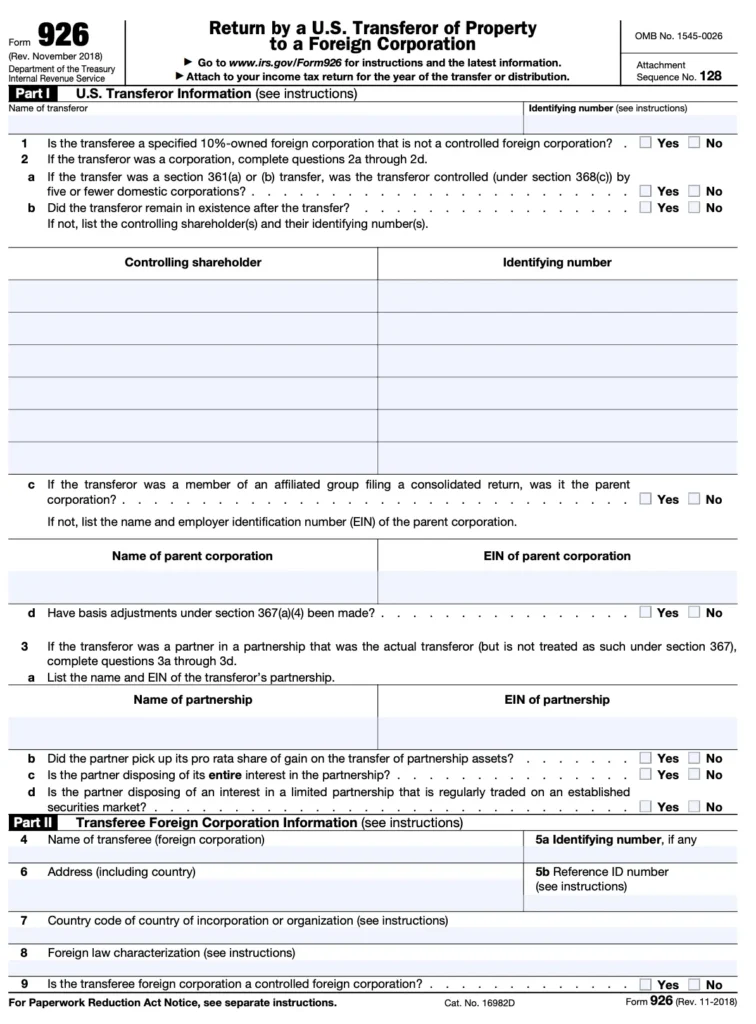IRS Form 926 (Return by a U.S. Transferor of Property to a Foreign Corporation) is required when U.S. persons transfer property to foreign corporations that meet certain thresholds. This form helps the IRS track cross-border transactions that may have tax implications.
Table of Contents
Who Must File Form 926?
You need to file this form if you:
- Transferred property worth more than $100,000 to a foreign corporation
- Are a U.S. person (individual, corporation, partnership, estate, or trust)
- Made transfers that could be taxable under Section 367
- Need to report certain organizational or reorganization transactions
Important: Some exceptions apply. Professional tax services can help determine your filing requirements.

Step-by-Step Guide to Completing Form 926
Step 1: Determine If Your Transfer Requires Filing
Review your transaction against IRS guidelines:
- Property types (tangible, intangible, stock, etc.)
- Transfer valuation methods
- Applicable exceptions
- Related party considerations
Step 2: Gather Required Documentation
Prepare:
- A detailed description of the transferred property
- Valuation documents and financial statements
- Corporate organizational documents
- Any relevant tax treaties or elections
- Prior year filings (if applicable)
Step 3: Complete Part I – Transferor Information
- Line 1a: Transferor’s name and address
- Line 1b: Transferor’s TIN (SSN/EIN)
- Line 1c: Transferor’s entity type
- Line 1d: Tax year of transfer

Step 4: Complete Part II – Transferee Information
- Line 2a: Foreign corporation’s name
- Line 2b: Foreign corporation’s address
- Line 2c: Country of incorporation
- Line 2d: Ownership percentage
Step 5: Complete Part III – Transfer Details
- Line 3: Description of transferred property
- Line 4: Fair market value of transfer
- Line 5: Tax basis of property
- Line 6: Gain recognition amount (if applicable)
Step 6: Complete Part IV – Additional Information
- Line 7: Section 367 elections
- Line 8: Tax treaty positions
- Line 9: Other required disclosures
Step 7: Sign and File
- Sign and date the form
- Mail to:
Internal Revenue Service
1973 North Rulon White Blvd.
Ogden, UT 84201
- Deadline: With your annual tax return or within 30 days of transfer
Common Mistakes to Avoid
- Missing filing deadlines – Strict timelines apply
- Undervaluing transferred property – Requires proper documentation
- Incomplete property descriptions – Must be specific
- Failing to report related party transactions – Common audit trigger
- Not reconciling with financial statements – Must match corporate records
Professional tax services ensure proper compliance with complex international transfers.
Advanced Considerations
Valuation Requirements
- Qualified appraisals for significant assets
- Intangible property valuation methods
- Currency conversion documentation
- Contemporaneous documentation standards
Tax Compliance
- Section 367(a) and (d) implications
- Gain recognition agreements
- Tax treaty benefits analysis
- Transfer pricing considerations
State Reporting
- State-level filing requirements
- Combined reporting implications
- Foreign corporation registration rules
- State tax credit opportunities

Final Thoughts
Proper completion of IRS Form 926 is critical for U.S. persons making transfers to foreign corporations. By maintaining detailed transaction records and accurate financial statements and carefully following the latest Form 926 instructions, you can meet your reporting obligations while managing tax exposure. For businesses with frequent international transactions, complex corporate structures, or significant asset transfers, partnering with professional tax services provides the expertise needed to navigate these sophisticated requirements.










